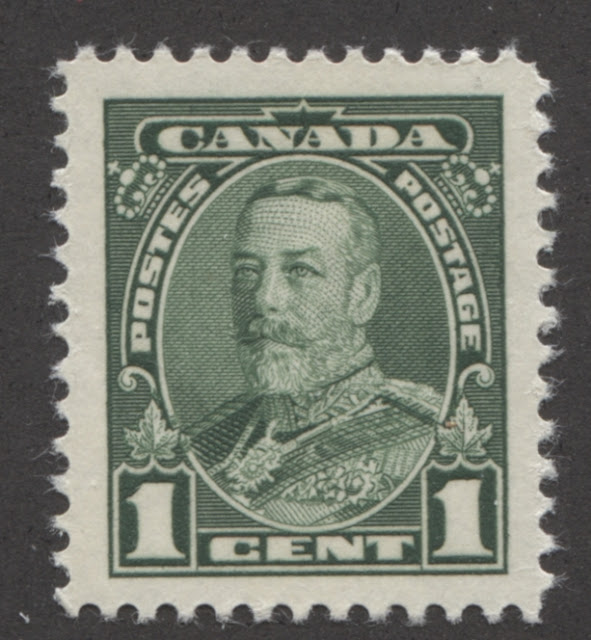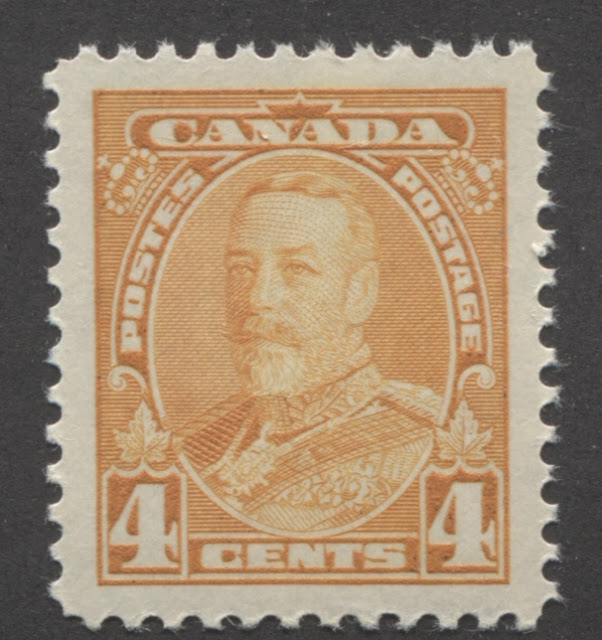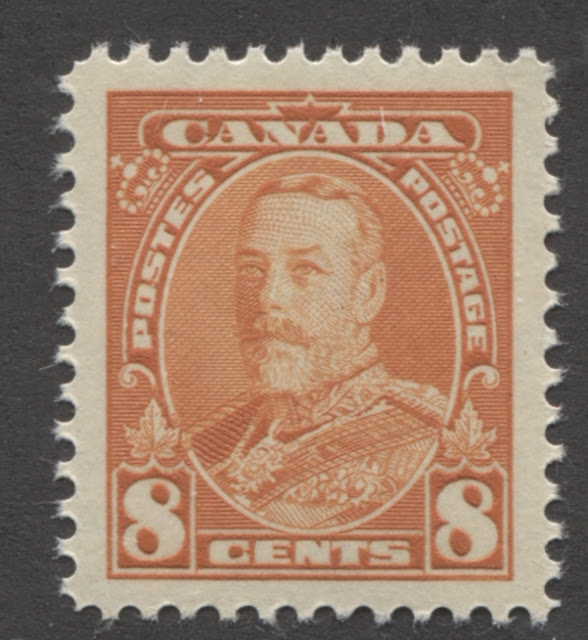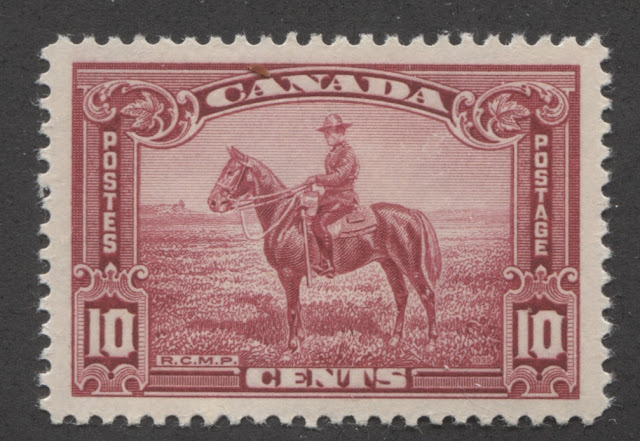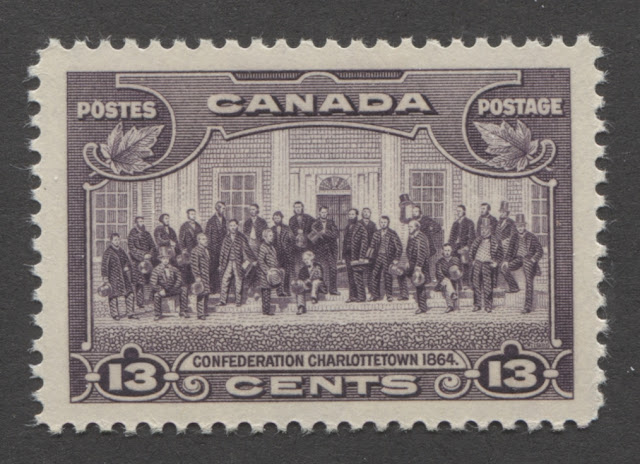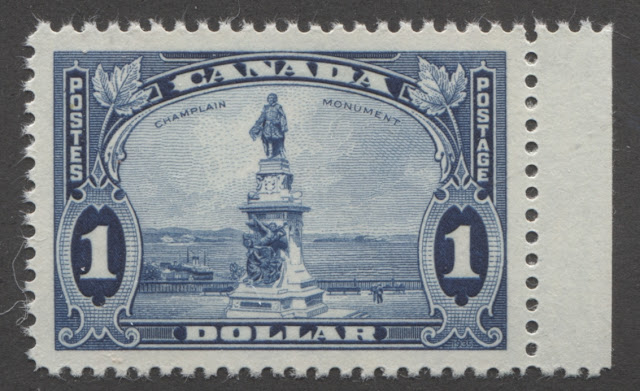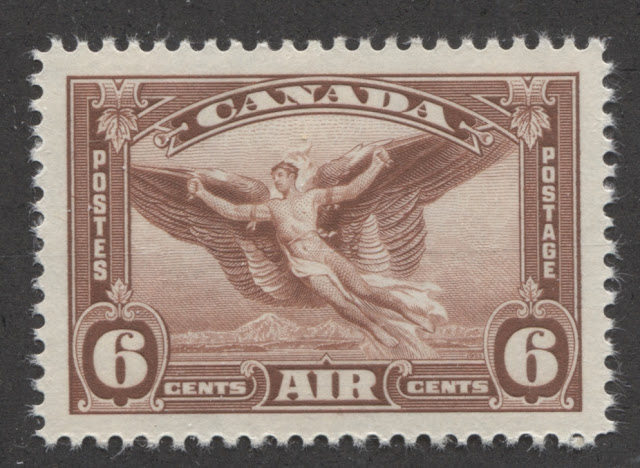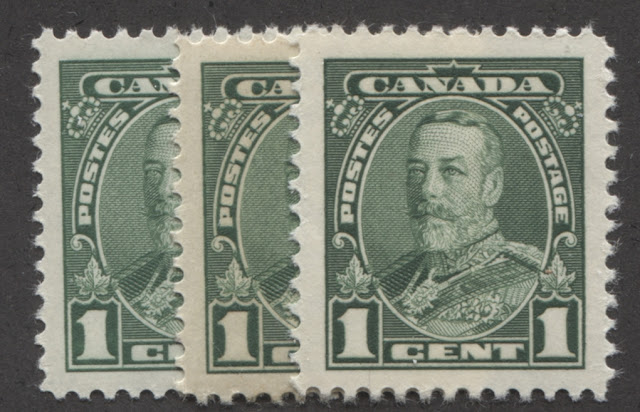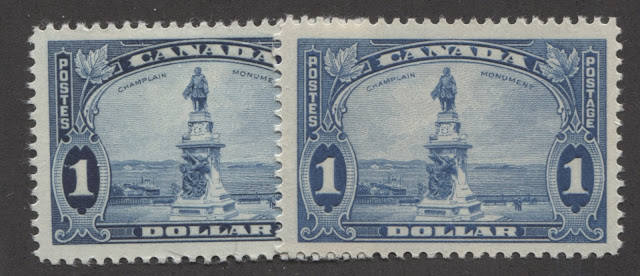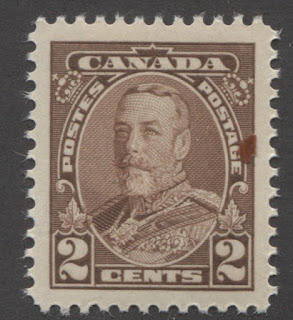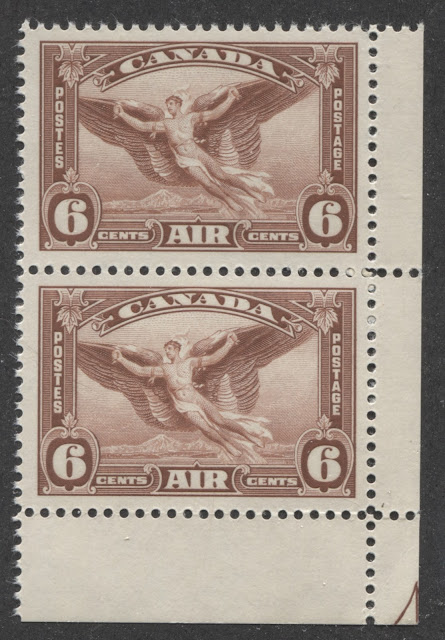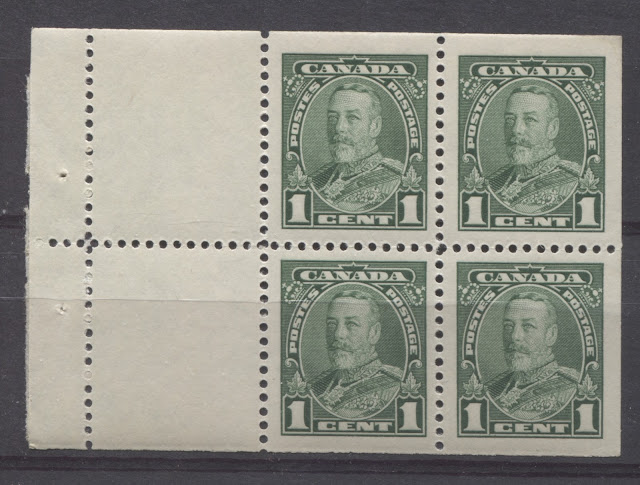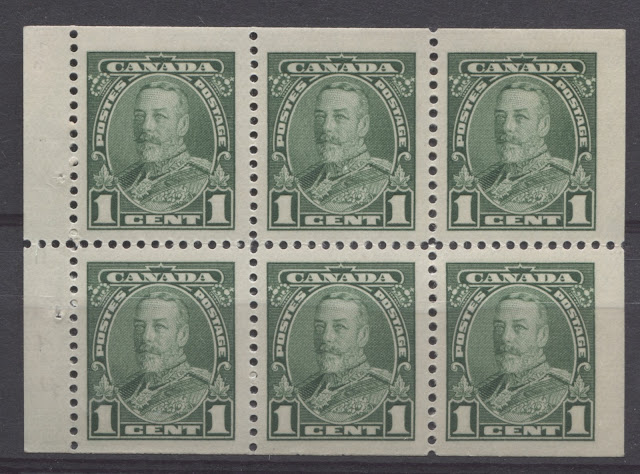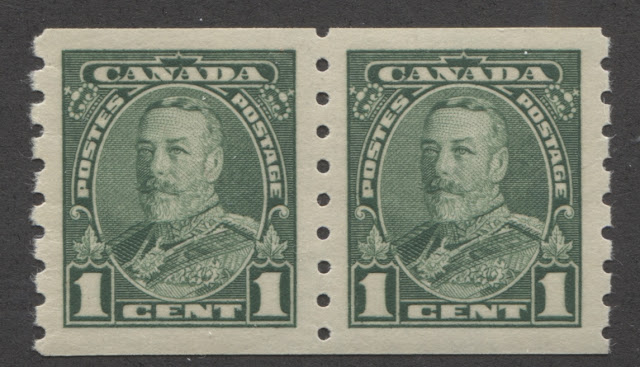Overview
Today's post will begin to look at what I consider to be the Canadian Bank Note Company's (CBN's) finest creation: The 1935-1938 Dated Die Issue. It combines ornateness of design, with beautiful, crisp printing and vibrant colours. The series offers just about everything a specialist could want, while offering immense challenges for the proof and imperforate material. The remainder of this post will explore the many possibilities that exist with this issue. I will cover all aspects of this issue in two posts, due to the large volume of material that there is to discuss.
The designer for all the stamps of this series was Herman Herbert Schwartz. His name figures very prominently in Canadian stamp design right into the late 1950's. Edwin Gunn, whose involvement in stamp design dates back to the Quebec Tercentenaries, was involved in the engraving of this issue, as was Arthur C Vogel, and William Adolph.
The issue date for all values was June 1, 1935, and this was the first issue to feature hidden year dates in the stamp designs, hence its nickname. All stamps from this issue forward incorporate the date into the design, so in a sense, this is a landmark issue.
The low values were printed in sheets of 400, which were guillotined into four post office panes of 100, while the high values were printed in sheets of 200, that were guillotined into four panes of 50.
The Stamp Designs and Quantities Issued
When one looks at the issue quantities for these stamps, it becomes apparent quite quickly that both the $1 and the 20c special delivery are very scarce stamps - even scarcer than the famous Bluenose. Yet curiously the Unitrade values do not reflect this scarcity at all, with the special delivery stamp being valued at just $16 for a very fine hinged example. Even the $1 has taken a hit in recent years, with Unitrade dropping the price of a very fine hinged copy to below $100, at $90. I do not feel that these prices will endure into the long-term, as the demand for them expands.
Points of Interest
The number of directions that a specialist can take this issue in, is vast, due to the amount of material that is available for the issue:
1. Shade varieties.
2. Paper and gum varieties.
3. Plate blocks.
4. Booklet panes and complete booklets.
5. Coil stamps.
6. Plate flaws and re-entries.
7. Precancels and cancellations.
8. First day covers and postal history.
9. OHMS perfins.
10. Imperforate varieties.
11. Proof material
Today's post will look at the first 5 of these, and then next week's post will explore the remaining aspects.
Shade Varieties
Nearly all of the stamps of this issue can be found with slight to marked variation in the colours. I find that it is the 6c airmail, 10c mountie and the 4c yellow that exhibit the most variation, but if you look closely, you will find shade varieties on every single value:
1c Green
On this value you can find a green that is both bright, and light, a regular, pure green, and then a deeper green that has a tinge of yellow to it. Most of the shades of this value are pure greens that vary only in terms of how bright or how deep they are.
2c Brown
On this value, the main aspects of variation are the brightness of the brown, as well as the amount of yellow contained in the brown. Unitrade does list a yellow brown, that does contain some yellow, but is really just a very pale version of the brown.
3c Carmine
The carmine varies in terms of the brightness, intensity and the amount of blue included in the colour. I have seen stamps in which the colour is a bright, deep tomato red, and others where the colour is a strong bluish carmine. In the above scan, there is quite a marked difference between the second and third stamps from the left, through they are all slightly different.
4c Yellow Orange
Here, the yellow varies in terms of the amount of orange included in the mix. I have seen stamps, that contain almost no orange, and are a pure, bright yellow. Others are almost entirely orange, with a golden tinge. However, most stamps you will see are a nearly perfect blend of yellow and orange. In the above scan, there is considerable variation in the shade of the three middle stamps.
5c Blue
The two main shades of blue that I have encountered are steel blue, which contains just a hint of grey, and Prussian blue, which contains just a hint of green. Both are very intense shades.
6c Red-Brown Airmail
The main two shades that you are likely to see on this stamp are bright red-brown and pale red brown. In both cases, the brown contains a clear reddish tone. There is a brown that does not contain the red undertone, being more like the colour of the 2c. Unitrade calls this the "yellow brown", though it is not the same as the yellow brown on the Stanley Gibbons colour key, nor is it the same as the yellow browns of the Queen Victoria period.
8c Orange
This shade varies both in terms of how bright the orange is, as well as the intensity. The shade on the left is duller, and less reddish than the one on the right.
10c Carmine
This value, in my opinion exhibits the most obvious variations of all the stamps in the series. On the one hand, you can find very deep carmine red, that is not overly bluish, and then very rosy carmine-rose shades that have a distinctly bluish undertone. At the same time, you can find other deep red shades that lack the blue, being more of a deep scarlet.
13c Violet
This stamp probably exhibits the least amount of variation of the stamps in the set, with the only variation I have seen, being the amount of red in the colour. On one end of the spectrum, there is the blackish purple, which contains the least red. Then there are the deep reddish lilac shades, which are noticably more reddish than the blackish purples.
20c Olive Green
This colour varies according to how much brown is included in the colour, as well as the intensity. Most of the stamps you will see are a deep olive green, which contains a hint of brown. The deep olive shade on the other hand contains less brown.
20c Carmine Special Delivery
This stamp is a fairly uniform carmine-red in terms of tone, but its intensity shows quite a bit of variation, from dark carmine-red to light carmine-red.
50c Dull Violet
This stamp is really not dull violet, but a blackish lilac. The shade varies from a deep blackish lilac, to a dull blackish lilac.
$1 Blue
This value exhibits surprisingly more variation than one might expect, based on only two shades listed in Unitrade. The most common shade is deep blue, and then from here, it varies according to both tone and intensity. There is a dark blue, that contains a bit of black in comparison to the more common deep blue. Then the colour can either be steel blue, with the usual hint of grey, or Prussian blue, with its usual hint of green. The pale blue, as listed in Unitrade, is really the pale Prussian blue, in my experience.
Paper and Gum Varieties
Other than the shades, the next big area for specialization are the papers and gum types. When these are combined with the study of shades, the number of possible shade-paper-gum combinations is really quite staggering. Interestingly, Unitrade does not even get into these aspects at all, even though they are quite clearly apparent on the stamps, and I believe, of vital importance to the study of the stamps themselves.
Paper types
There are at least three types of paper on the sheet and booklet stamps, and two on the coil stamps. They vary with respect to two attributes:
The stamp on the left is the pure white gum with a semi-gloss sheen, while the other two are light cream, with a semi-gloss sheen.
Deep Cream and Yellow Gums
These gums tend to be either very slightly streaky, with a semi-gloss sheen, or they are of a very high gloss sheen, as illustrated in the scans below:
On the left, we have the slightly streaky cream gum, and on the right, the deep cream gum. Both of these gums have a semi-gloss sheen. The scan below shows the deep cream gum with a satin sheen:
The above gum also exists with a crackly appearance, rather than the smooth appearance shown above.
Finally, there is the deep yellow gum with the glossy sheen, such as on the 20c special delivery stamp:
Brownish Gums
The brownish gums all generally have a satin-like sheen, and can appear either streaky or mottled. The scan below shows one such gum on the 2c brown:
Plate Blocks
There are a good range of plates used to print the stamps of this series. The usual four positions exist for each plate, and are generally collected in blocks of 6 or 10 on the low values, and either blocks of 4 or 6 on the high values. In addition to these, some of the low values also come with a centre position, that is generally collected as a block of 8.
The basic set of plate blocks, consists of:
Booklet Panes and Complete Booklets
This is the last issue to have been produced with the booklets having the simple, typographed covers featuring the arms design. This makes collecting the booklets a rather simple task, as there were four basic booklets, each of which was issued in both English and French versions as follows:
Today's post will begin to look at what I consider to be the Canadian Bank Note Company's (CBN's) finest creation: The 1935-1938 Dated Die Issue. It combines ornateness of design, with beautiful, crisp printing and vibrant colours. The series offers just about everything a specialist could want, while offering immense challenges for the proof and imperforate material. The remainder of this post will explore the many possibilities that exist with this issue. I will cover all aspects of this issue in two posts, due to the large volume of material that there is to discuss.
The designer for all the stamps of this series was Herman Herbert Schwartz. His name figures very prominently in Canadian stamp design right into the late 1950's. Edwin Gunn, whose involvement in stamp design dates back to the Quebec Tercentenaries, was involved in the engraving of this issue, as was Arthur C Vogel, and William Adolph.
The issue date for all values was June 1, 1935, and this was the first issue to feature hidden year dates in the stamp designs, hence its nickname. All stamps from this issue forward incorporate the date into the design, so in a sense, this is a landmark issue.
The low values were printed in sheets of 400, which were guillotined into four post office panes of 100, while the high values were printed in sheets of 200, that were guillotined into four panes of 50.
The Stamp Designs and Quantities Issued
1c Green, King George V.
Issued: June 1, 1935.
Replaced: April 1, 1937.
355,494,000 sheet stamps.
2,270,000 booklet stamps.
9,625,000 coil stamps.
2c Brown, King George V.
Issued: June 1, 1935.
Replaced: April 1, 1937.
331,000,000 sheet stamps.
2,335,000 booklet stamps.
13,500,000 coil stamps.
3c Carmine-red, King George V.
Issued: June 1, 1935.
Replaced: April 1, 1937.
701,490,000 sheet stamps.
12,194,400 booklet stamps.
25,080,000 coil stamps.
4c Yellow-orange, King George V.
Issued: June 1, 1935.
Replaced: May 10, 1937.
7,037,000 stamps.
5c Steel blue, King George V.
Issued: June 1, 1935.
Replaced: May 10, 1937.
41,045,000 stamps.
8c Deep orange, King George V.
Issued: June 1, 1935.
Replaced: May 10, 1937.
3,066,000 stamps.
10c Carmine-rose, Mountie on horseback.
Issued: June 1, 1935.
Replaced: June 15, 1938.
4,086,000 stamps.
13c Violet, Charlottetown Conference.
Issued: June 1, 1935.
Replaced: November 15, 1938.
8,035,000 stamps.
20c Deep olive green, Niagara Falls.
Issued: June 1, 1935.
Replaced: June 15, 1938.
13,513,000 stamps.
50c Dull violet, Parliament Buildings, Victoria, BC.
Issued: June 1, 1935.
Replaced: June 15, 1938.
2,416,000 stamps.
$1 Deep blue, Champlain Monument, Quebec City.
Issued: June 1, 1935.
Replaced: June 15, 1938.
818,000 stamps.
6c Bright red-brown, Daedalus in flight.
Issued: June 1, 1935.
Replaced: June 15, 1938.
5,000,000 stamps.
20c Bright carmine-red, allegory of Mercury.
Issued: June 1, 1935.
Replaced: June 15, 1938.
883,814 stamps
When one looks at the issue quantities for these stamps, it becomes apparent quite quickly that both the $1 and the 20c special delivery are very scarce stamps - even scarcer than the famous Bluenose. Yet curiously the Unitrade values do not reflect this scarcity at all, with the special delivery stamp being valued at just $16 for a very fine hinged example. Even the $1 has taken a hit in recent years, with Unitrade dropping the price of a very fine hinged copy to below $100, at $90. I do not feel that these prices will endure into the long-term, as the demand for them expands.
Points of Interest
The number of directions that a specialist can take this issue in, is vast, due to the amount of material that is available for the issue:
1. Shade varieties.
2. Paper and gum varieties.
3. Plate blocks.
4. Booklet panes and complete booklets.
5. Coil stamps.
6. Plate flaws and re-entries.
7. Precancels and cancellations.
8. First day covers and postal history.
9. OHMS perfins.
10. Imperforate varieties.
11. Proof material
Today's post will look at the first 5 of these, and then next week's post will explore the remaining aspects.
Shade Varieties
Nearly all of the stamps of this issue can be found with slight to marked variation in the colours. I find that it is the 6c airmail, 10c mountie and the 4c yellow that exhibit the most variation, but if you look closely, you will find shade varieties on every single value:
1c Green
On this value you can find a green that is both bright, and light, a regular, pure green, and then a deeper green that has a tinge of yellow to it. Most of the shades of this value are pure greens that vary only in terms of how bright or how deep they are.
2c Brown
On this value, the main aspects of variation are the brightness of the brown, as well as the amount of yellow contained in the brown. Unitrade does list a yellow brown, that does contain some yellow, but is really just a very pale version of the brown.
3c Carmine
The carmine varies in terms of the brightness, intensity and the amount of blue included in the colour. I have seen stamps in which the colour is a bright, deep tomato red, and others where the colour is a strong bluish carmine. In the above scan, there is quite a marked difference between the second and third stamps from the left, through they are all slightly different.
4c Yellow Orange
Here, the yellow varies in terms of the amount of orange included in the mix. I have seen stamps, that contain almost no orange, and are a pure, bright yellow. Others are almost entirely orange, with a golden tinge. However, most stamps you will see are a nearly perfect blend of yellow and orange. In the above scan, there is considerable variation in the shade of the three middle stamps.
5c Blue
The two main shades of blue that I have encountered are steel blue, which contains just a hint of grey, and Prussian blue, which contains just a hint of green. Both are very intense shades.
6c Red-Brown Airmail
The main two shades that you are likely to see on this stamp are bright red-brown and pale red brown. In both cases, the brown contains a clear reddish tone. There is a brown that does not contain the red undertone, being more like the colour of the 2c. Unitrade calls this the "yellow brown", though it is not the same as the yellow brown on the Stanley Gibbons colour key, nor is it the same as the yellow browns of the Queen Victoria period.
8c Orange
This shade varies both in terms of how bright the orange is, as well as the intensity. The shade on the left is duller, and less reddish than the one on the right.
10c Carmine
This value, in my opinion exhibits the most obvious variations of all the stamps in the series. On the one hand, you can find very deep carmine red, that is not overly bluish, and then very rosy carmine-rose shades that have a distinctly bluish undertone. At the same time, you can find other deep red shades that lack the blue, being more of a deep scarlet.
13c Violet
This stamp probably exhibits the least amount of variation of the stamps in the set, with the only variation I have seen, being the amount of red in the colour. On one end of the spectrum, there is the blackish purple, which contains the least red. Then there are the deep reddish lilac shades, which are noticably more reddish than the blackish purples.
20c Olive Green
This colour varies according to how much brown is included in the colour, as well as the intensity. Most of the stamps you will see are a deep olive green, which contains a hint of brown. The deep olive shade on the other hand contains less brown.
20c Carmine Special Delivery
This stamp is a fairly uniform carmine-red in terms of tone, but its intensity shows quite a bit of variation, from dark carmine-red to light carmine-red.
50c Dull Violet
This stamp is really not dull violet, but a blackish lilac. The shade varies from a deep blackish lilac, to a dull blackish lilac.
$1 Blue
This value exhibits surprisingly more variation than one might expect, based on only two shades listed in Unitrade. The most common shade is deep blue, and then from here, it varies according to both tone and intensity. There is a dark blue, that contains a bit of black in comparison to the more common deep blue. Then the colour can either be steel blue, with the usual hint of grey, or Prussian blue, with its usual hint of green. The pale blue, as listed in Unitrade, is really the pale Prussian blue, in my experience.
Paper and Gum Varieties
Other than the shades, the next big area for specialization are the papers and gum types. When these are combined with the study of shades, the number of possible shade-paper-gum combinations is really quite staggering. Interestingly, Unitrade does not even get into these aspects at all, even though they are quite clearly apparent on the stamps, and I believe, of vital importance to the study of the stamps themselves.
Paper types
There are at least three types of paper on the sheet and booklet stamps, and two on the coil stamps. They vary with respect to two attributes:
- Whether or not they have a smooth or ribbed surface.
- How readily visible the mesh is when the stamp is laid face down and viewed from the back.
The scans below show the smooth and ribbed surface papers:
Here you can readily see the differences between the smooth paper at the top, and the horizontal ribbed paper on the bottom. Generally speaking, on the sheet stamps, the ribbed paper is always horizontal wove.
The smooth paper on the sheet stamps is generally always vertical wove. The smooth paper varies further by whether or not the mesh is visible from the back. The scans below show a typical group of stamps with mesh that is either visible, or not visible:
The stamps at either end show clear vertical mesh, whereas the stamp in the middle does not show any clear mesh in the paper.
On the coil stamps, the paper is usually either a smooth horizontal wove that shows either very fine mesh, or no mesh, or it is a vertical wove that can show very light vertical ribbing on the paper surface.
Gum Types
The gum is the one characteristic that shows the most variation. The gum on this issue varies both in terms of colour, and sheen.
Generally speaking the gums can be divided into three colour groups:
1. White and light cream.
2. Deep cream and yellow.
3. Brown gums.
White and Light Cream Gums
The scan below shows three stamps from this group:
The stamp on the left is the pure white gum with a semi-gloss sheen, while the other two are light cream, with a semi-gloss sheen.
Deep Cream and Yellow Gums
These gums tend to be either very slightly streaky, with a semi-gloss sheen, or they are of a very high gloss sheen, as illustrated in the scans below:
On the left, we have the slightly streaky cream gum, and on the right, the deep cream gum. Both of these gums have a semi-gloss sheen. The scan below shows the deep cream gum with a satin sheen:
The above gum also exists with a crackly appearance, rather than the smooth appearance shown above.
Finally, there is the deep yellow gum with the glossy sheen, such as on the 20c special delivery stamp:
Brownish Gums
The brownish gums all generally have a satin-like sheen, and can appear either streaky or mottled. The scan below shows one such gum on the 2c brown:
The scan below shows the brownish cream gum with a high gloss sheen, on a pair of the 2c brown coil:
I have not completed, nor am I aware of any comprehensive study that shows, which paper and gum types exist with a particular shade. The number of possible combinations, given the paper and gum types shown is staggering: 13 stamps x 3 papers x 8 gums = 312 basic stamps! And that is not taking shade varieties into account. If each stamp is assumed to exist in 2 shades, then that number doubles and becomes 624 basic stamps.
Plate Blocks
There are a good range of plates used to print the stamps of this series. The usual four positions exist for each plate, and are generally collected in blocks of 6 or 10 on the low values, and either blocks of 4 or 6 on the high values. In addition to these, some of the low values also come with a centre position, that is generally collected as a block of 8.
The basic set of plate blocks, consists of:
- 1c green - plates 1-3 all positions - 15 blocks.
- 2c brown - plate 1-4, all positions - 20 blocks.
- 3c carmine - plates 1-8, all positions - 40 blocks.
- 4c yellow-orange - plate 1, all positions - 5 blocks.
- 5c blue - plates 1-2, all positions - 10 blocks.
- 8c deep orange - plate 1, all positions - 5 blocks.
- 10c carmine-rose - plates 1-2, all positions - 10 blocks.
- 13c violet - plates 1-2, all positions - 10 blocks.
- 20c olive green - plates 1-2, all positions - 10 blocks.
- 50c dull violet - plate 1, all positions - 5 blocks.
- $1 deep blue - plate 1, all positions - 5 blocks.
- 6c bright red brown - plate 1, all positions - 5 blocks
- 20c bright carmine-red, plate 1, all positions - 4 blocks
That makes 144 plate blocks all together. If you were to combine these with the paper and gum varieties above, you would have almost 7,000 collectible plate blocks, if each one existed in 2 shades, 3 paper types and 8 gum types. Of course the number of actual varieties that one can collect is likely to be far fewer than that, but still a much greater scope than most of you reading this would imagine, I reckon.
Although not listed in Unitrade, it is possible to collect blocks of pairs that show all or part of the arrow cutting guideline that was used in the guillotining of the sheets, when being distributed to the post offices. The scan below shows an example of the 6c airmail with an arrow cutting guideline:
Booklet Panes and Complete Booklets
This is the last issue to have been produced with the booklets having the simple, typographed covers featuring the arms design. This makes collecting the booklets a rather simple task, as there were four basic booklets, each of which was issued in both English and French versions as follows:
- The 1c green in 4 panes of 6. Housed in green cover, with black coat of arms. This booklet was issued on August 19, 1935. 102,000 English booklets and 11,400 French booklets were issued.
- The 2c brown in 2 panes of 6. Housed in a brown cover with black coat of arms. This booklet was issued on November 16, 1935. 102,400 English booklets, and 21,700 French booklets were issued.
- The 3c carmine in 2 panes of 4 plus 2 labels. Housed in a light red cover, with black coat-of-arms. This booklet was the first one issued on June 1, 1935. This is easily the most common booklet, with 2,350,000 English booklets, and 301,000 French booklets issued.
- One pane of 4 of each value, plus 2 labels. Housed in a buff cover, with black coat of arms. This booklet was issued on July 22, 1935. 370,000 English booklets and 27,600 French booklets were issued.
Although the French booklets are double the price in Unitrade, they are a much better investment, given that they are generally ten times scarcer than the English booklets.
The scans below show what the panes inside the booklets look like:
A pane of 4 stamps, plus 2 blank labels.
A pane of 6 stamps.
I do not know how many separate printings were made to come up to the total issue quantities for the booklets shown above. However, I do note that there are a fair number of different paper and gum types on the panes I have handled, so I think there must have been several different printings made between 1935 ad 1937.
Coil Stamps
As was customary with the precedent set by the earlier issues, the three most commonly issued stamps were issued in rolls of 500 stamps, perforated 8 vertically. This is the coarsest perforation used on any Canadian stamp, and results in difficulty in locating examples with full , even perforations on both sides.
These are the first coils to be produced after 1935 by the CBN, and the method employed by them to produce coil stamps has remained largely unchanged since. This means that varieties like wide and narrow spacing strips, which are listed on some of the Elizabethan issues, should theoretically exist on these, as should strips showing the cutting guideline. Unitrade does not list any of these, but if you are going to collect the coil stamps, you should be on the lookout for them, in addition to the usual jump strips. As a point of reference, the normal spacing between stamp impressions in the roll is 4 mm. In addition to spacing varieties, repair paste-ups can be collected for each stamp, and all three stamps can be collected in both start strips, and end strips. In addition to having the 10 blank tabs in a different order (at the beginning on a start strip, or the end, in the case of an end strip), the colour of the tabs themselves is different.
As stated in the section dealing with paper and gum types, there are at least four different paper and gum combinations possible for each of the stamps. When you combine each of these paper-gum combinations with the spacing, cutting and repair varieties above, the true possibilities of scope for these stamps becomes more apparent.
There are two well known plate flaws listed in Unitrade for these coil stamps: the "narrow 1" and the "damaged 2". I will cover these in more depth in next week's post.
This concludes my detailed discussion of the first five aspects of this beautiful issue. I hope after reading this, that you are able to see more possibilities for collecting this issue in detail than you might have thought possible before.


